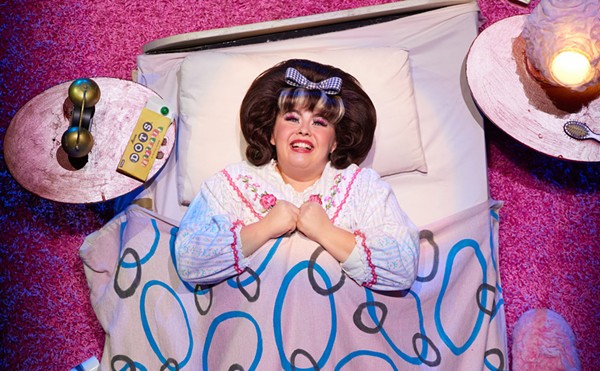In the second act of Gregg Barrios’ new play, Rancho Pancho, 21-year-old Benny Briseño unbuttons his sweaty cotton shirt to reveal tight pectorals and a V-shaped torso pointing down to his shaved caramel pubis. Playing the part of Tennessee Williams’ Mexican-American lover Francisco “Pancho” Rodriguez, Briseño walks to the writing table where Williams (superbly played by Rick Frederick) and Carson McCullers (Anna Gangai) have been busy writing, and asks: “Who wants to go first?”
The rest is history, as they say, but after the final curtain call on Tennessee’s dark secret Friday night at the Jump-Start, American literary history can never be the same. Pancho fucked it. And it fucked him.
Briseño hits every high and low note of a character who realizes he is a “kept boy” while still insisting on retaining his dignity, and family autonomy, in the face of vulture-like authors who built lucrative careers writing about the lives of others less fortunate.
Barrios’ play, which had its first incarnation in 2002 with the help of a Ford Foundation Gateway Grant, is titled after Williams’ reference to the Nantucket beachside resort where he, Pancho, and McCullers retreated in 1946 for a summer of literary debauchery. The play is based on actual events, which Barrios, an occasional Current contributor, spent a decade researching.
Barrios’ archive includes startling discoveries, such as a European postcard to Pancho from McCullers and her husband alluding to a ménage à trois in Nantucket. The biggest find is a cardboard acetate recording of Pancho playing the role of Stanley Kowalski, the character Marlon Brando made famous in Williams’ A Streetcar Named Desire.
The nucleus of Barrios’ play is Pancho, who becomes a Pirandello-like character who curses Williams for pimping out his life to create characters and scenes. Streetcar becomes a particularly sore point for Pancho when he realizes their pillow talk is grist for Tennessee’s theater mill. Williams went so far as to model the woman selling funeral flowers (“flores para los muertos”) on Pancho’s mother, who sold handmade wreaths in Piedras Negras, Mexico, where Tennessee and Pancho met.
The play’s bombshell is Barrios’ assertion that Stanley was modeled on Pancho. Williams changes him to a Polish character at his director’s urging, so the play will have a “larger audience.”
Pancho retorts: “But there aren’t any Pollacks in New Orleans!,” and “Pollacks don’t go to the theater!”
Similar to Barrios’s theatrical archeology of Katherine Ann Porter’s predilection for dark-skinned lovers in Dark Horse, Pale Rider (staged at the San Pedro Playhouse in 2002), Rancho Pancho exposes the heretofore unknown Mexican-American influences on Williams’ work. In an email interview with the San Antonio Current, Barrios observed, “One can easily find in their diaries references to the influence that Mexico, and by extension Mexican Americans, had on American writers. Think Hart Crane, Jack Kerouac, Malcolm Lowry `Under the Volcano`, John Reed, etc.
“Yet I don’t think scholars necessarily understand the importance of our influence. Another aspect of this is that too often Latinos aren’t considered part of the mainstream ... The influence that Oscar Zeta Acosta had on Hunter Thompson is another case in point. We wind up marginalized or even whitewashed out of the story. It therefore falls on we as artists, writers, and scholars to put their stories, our stories, into the public and historical consciousness.”
However compelling such a revisionist project may be, it must be presented as good theater for its message to hit home. The capacity crowds at Jump-Start on Friday and Saturday nights suggest that it was. At the audience-director feedback session on Friday, the consensus was that the writing was “tight” and the casting “perfect.” The only change that was suggested was the elimination of the happy ending in which Pancho and Tennessee sit watching a movie in favor of the penultimate scene, in which Tennessee sits at his writing table gazing upon a stabbed painting of Pancho as he writes.
This quibbling aside, Briseño and Frederick brought to life the conflicted relationship between Pancho and Tennessee through tense domestic scenes, where intense erotic love lingered just above a deep well of resentment at one another’s frequent betrayals and, above all else, Williams’ appropriation of Pancho, his brother, and mother. Their onstage broken bottle thrust and parries were not only highly erotic — with a great sex scene — but downright dangerous.
Decades after A Streetcar Named Desire premiered, American playwrights are still measured by their success in drawing the complex, wounded, loathsome and lovable characters Williams created. In Rancho Pancho, Barrios creates a three-dimensional Tennessee not seen before. He also gives us a Pancho who is not only as complex as Kowalski, but he shows us that Pancho is in fact him, or vice versa.
In the world of theater, where appraisals count most when they come from fellow playwrights, Luis Valdez put it best in a note to Barrios: “Congratulations! I knew it would work. You have written a wonderful piece of theater and served a delicious slice of history. ¡Dale gas, carnal!” •
Rancho Pancho returns to San Antonio October 9-18 at SAY Sí after a featured production at the Provincetown Tennessee Williams Theater Festival September 25-28.















